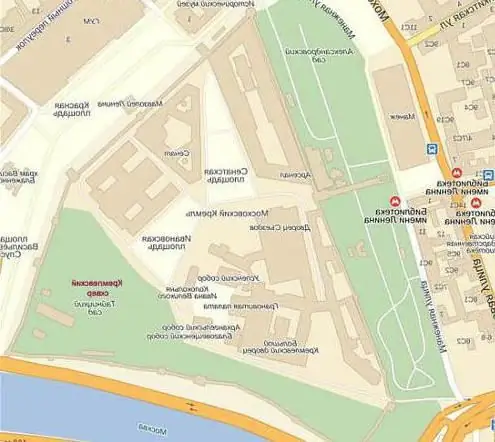- Author Harold Hamphrey [email protected].
- Public 2023-12-17 10:06.
- Last modified 2025-01-24 11:10.
Among country residences located in the suburbs of Northern Palmyra, Oranienbaum stands out. Its sights are included in the art complex, created by the inspired work of famous architects, talented craftsmen, painters and masters of arts and crafts of the 18th century and occupying a special place in the history of Russian and world culture.
Oranienbaum
In 1707, the lands near the confluence of the Karasta River into the Gulf of Finland were granted by Peter I (emperor) to his associate Alexander Menshikov, who at that time was the governor of Ingermanland, which ceded to the Russian Empire at the end of the Northern War. By order of the emperor's favorite, on the coastal site opposite Kotlin Island, architects G. Shedel and D. Fontana erected the Grand Palace, which is practically not inferior in its splendor to the emperor's palace in Peterhof. The Lower Regular Garden, one of the first in Russia, was also designed here. Around the country residence of Alexander Menshikov, which he named Oranienbaum,a palace settlement of the same name arose.

The origin of the unusual name is trying to be explained by different versions. One of the legends says that during the time of the favorite of Peter I there was an orange greenhouse (Oranienbaum in German means an orange tree). On the terraces and open staircases of the Grand Palace in the summer, a curiosity for the North was exhibited in tubs - evergreens of the genus citrus.
History of the residence
During its history of more than 300 years, the residence has changed many owners, and the settlement received the status of a city.
In 1743 the residence was given as a gift to Peter III, who ascended the throne in 1761. After the palace coup of 1762, a palace was built for Catherine II in Oranienbaum, which was included in the "Own Dacha" complex. The buildings of his buildings became the only examples of the rococo architectural style presented in Russia.
Since 1796, the country residence was the property of the imperial family and passed on to the next generations. Before the revolution, its last owners were the Dukes of Mecklenburg-Strelitz.

After the events of 1917, part of the buildings of the historical and architectural monument were transferred to the Forest College based on the territory of Oranienbaum. Museums were opened in some palaces, in particular in the Chinese one. In 1948 the city was renamed Lomonosov. "Oranienbaum" (as the name) was preserved only behind the historical complex. The assignment of the name of the great Russian scientist to the city did not happen by chance. Not far from here, in the village of Ust-Ruditsa, there was his estate and a laboratory for the preparation of colored glass.
In the post-war period, Oranienbaum fell into disrepair, its serious restoration began only in the late 90s.
In 2007, the unique complex was introduced into the Peterhof State Museum-Reserve. It should be noted that in the suburbs of St. Petersburg the only one that was not destroyed during the Second World War and retained its historical authenticity was the historical and architectural ensemble "Oranienbaum", the sights of which complete the series of representative residences of the Peterhof road.
Architectural and landscape complex

The palaces and parks of Oranienbaum make up three artistic ensembles that were created during the 18th century. Antonio Rinaldi played an exceptional role in their creation. The manner of the Italian architect was distinguished by rationalism, interspersed with conservatism. In Oranienbaum, his works are the Chinese Palace, the Opera House, the Palace of Peter III and the Rolling Hill.
All park structures make up a peculiar composition, which is divided into the Lower Garden with the Menshikov Palace and the Upper Park with its numerous historical monuments.
Unique buildings of the Peter the Great era
The construction of the Grand Palace and the creation of the Lower Park around it, a distinctive feature of which is architectural and artistic unity, was the beginning of the creation of the complexOranienbaum. The sights of this part of the architectural complex, in addition to the Menshikov Palace, include the Catherine Building, the Monplaisir Palace, the Marly Palace, the Sea Canal and the most beautiful alleys of fountains.
All of them have survived to our time. The Grand Palace itself, despite repeated alterations, has not changed its appearance much. It has always remained close to its original design, which makes it possible to rank it among the unique constructions of the Petrine era.
Landscape Art

In the landscape art of that time, they already tried to deviate from the principles of regular gardening. When creating the Upper Park, Rinaldi managed to achieve a smooth transition from one of its stylistic parts to another. The talented master took into account the peculiarities of the picturesque area that distinguishes Oranienbaum. The park, consisting of the Own Dacha and the Petershtad Ensemble, has merged into one. It does not have strict lines, neatly trimmed tree crowns, characteristic of a regular layout. On the other hand, a harmonious unity is clearly felt, in which complex geometric patterns of alleys, playgrounds, a water labyrinth of ponds and artificial lakes connected by channels, a riot of wildlife and unique architecture have merged. The latter is represented by a unique combination of rococo style with elements of still emerging classicism.
Artistic design. Synthesis of beauty and expediency
An exceptional feature of the Upper Park is that its layout and designs of all structures in it are made by onearchitect. The artistic design of Rinaldi combined the magic of the synthesis of beauty and expediency. A mixture of different styles in decor, a combination of regular and landscape principles, equal participation of the methods of both directions distinguishes Oranienbaum, the sights of which harmoniously merged into a single whole with the landscape, striking with their beauty and grandeur.
Architectural and artistic ensembles of the park
In the depths of the Upper Park, the Chinese Palace opens up, which is part of the Own Dacha complex. Interestingly, the building was originally called the "Dutch house". The new name appeared later and was more likely due to the fashion for "Chinese". The decoration of the interiors of the palace is made in the spirit of Chinese and Japanese art.

The Own Dacha complex also includes the famous Pergola arbor, consisting of 54 pylons and a stone staircase descending to the water of the pond. It was created in the 19th century and is an excellent decoration of the garden and park architecture of that time. The pergola was erected on the site of the Coffee House, which was never brought to life by Rinaldi.
Attention is drawn to the Rolling Hill, which is a grandiose park structure. Here, the courtiers had fun riding down the ice slides, one after the other and making up a length of 532 meters. Traditional folk fun was also available in the summer.
The "Stone Hall" building was probably intended for concerts. It currently houses an interactive cinema andexhibition of interior and park sculpture.
In the Upper Park you can also see the Cavalier Corps, the Gate of Honor, the pavilion called "Chinese cuisine".
Petrovsky Park
Petrovsky Park is another creation of Rinaldi. Its layout was carried out with the participation of master Lamberti. When it was created on the principle of Italian gardens, elements of a regular direction were also used. Numerous cascades, terraces are interspersed with miniature pavilions, among which are the two-story Hermitage, Solovyov's gazebo, Chinese house.
Now Petrovsky Park is made in landscape style. Its compositional basis is the Karasta River, the Upper and Lower Ponds.
How to get to Oranienbaum?

Royal residences in the vicinity of St. Petersburg are included in a variety of excursion tours. You can visit them on your own, if you know in advance how to get there.
Oranienbaum is located in the city of Lomonosov, located 40 kilometers from the northern capital. The best way to get here is from the southeastern part of the city. So, you can get to the Oranienbaum railway station (in Lomonosov) from the Avtovo metro station by minibus K-424a, bus No. 200; from the station "Prospect Veteranov" - by bus number 343. Electric trains depart regularly from B altiysky Station to Lomonosov.
Earlier, it was possible to get from Kronstadt to the museum-reserve by ferry, now it is easier to get by bus No. 175.
Portable travel guide
There is a map at the entrance to the parkwith the key places that Oranienbaum is famous for. A photo of the plan in the future will help to plan your excursion correctly. It is worth paying attention to the instructions for downloading a portable guide to the park - this is an electronic application "Park Oranienbaum". It contains a plan, coat of arms, information about the history of the complex and a short video.






